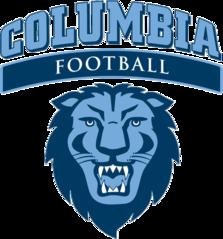First season 1870 Seating capacity 17,000 Location New York, New York Head coach Pete Mangurian Colors Columbia Blue, White | Athletic director Peter Pilling NCAA division Division I FCS Division Division I (NCAA) Mascot Roaree the Lion | |
 | ||
The Columbia Lions football program is the intercollegiate American football team for Columbia University located in the U.S. state of New York. The team competes in the NCAA Division I Football Championship Subdivision (FCS) and are members of the Ivy League. Columbia played in what is generally regarded as the fourth college football game on November 12, 1870 against Rutgers University in New Jersey. This was the first interstate football game ever played. The first three college football games were played between Princeton and Rutgers in 1869 and 1870. Columbia plays its home games at the 17,000 seat Wien Stadium in Inwood, Manhattan, the northern-most neighborhood on Manhattan island.
Contents
- 2011 columbia lions football
- The beginning 18701899
- The 20th Century
- The Streak
- Notable Lions
- Notable alumni
- Championships
- Conference championships
- Cornell Big Red
- Fordham Rams
- Georgetown Hoyas
- References
2011 columbia lions football
The beginning (1870–1899)
Sometime in early November 1870 – while November 12th is most cited, others claim November 5 or 11th – Columbia's intercollegiate football journey began with a short trip to New Brunswick, NJ to play Rutgers, which they lost 3–6 in the first college football game between schools from different states. The school struggled for most of the 19th century, and it was not until after the turn of the century to which the team would have any success.
The 20th Century
The program was much more successful in the first half of the 20th century, and was at times a national power. The 1915 squad went undefeated and untied. The 1933 Lions won an unofficial national championship by upsetting the top-ranked Stanford Indians 7–0 in the Rose Bowl on New Years Day. Lou Little, who coached the team from 1930 to 1956, is in the College Football Hall of Fame.
The Streak
Between 1983 and 1988, the team did not have a win in 47 games and lost 44 games in a row, which was the record for the NCAA Football Championship Subdivision until Prairie View A&M broke the record en route to 80 consecutive losses from 1989–1998. In the fifth game of the 1983 season, they won 21–18 over Yale. After that game, they did not win a game again for almost five years. The streak began with a tie with Bucknell in the following game, and ending the season with a loss to Holy Cross, a tie with Dartmouth, and losses to Cornell and Brown. The losing streak was so bad, that at one point, when the team came out on the field, the school's band would play the theme to The Mickey Mouse Club rather than their fight song. One notable loss during the streak was in a 1985 game vs. Harvard, where the Lions led 17–0 with 5 minutes left in the 3rd quarter, only to see the Crimson score 7 touchdowns in the remaining time to lose 49–17. After their 35th loss, they set the record for the longest Division I losing streak in history (beating Northwestern's 34 game losing streak from 1979–1982). After this game, Larry McElreavy, the current coach at the time told reporters, "I'm realistic; there's not a lot of talent here." ESPN rated the 1983–1988 Lions teams at 4th in its list of the top 10 worst college football teams of all time. The streak was broken on October 8, 1988, with a 16–13 victory over archrival Princeton after a missed field goal attempt by the Tigers late in the game. Matthew Fox most notably played on the '88 team. That was the Lions' first victory at Wien Stadium, which was already four years old, having been opened during the streak.
Notable Lions
Pro Football Hall of Famer Sid Luckman played his college ball at Columbia, graduating in 1938. Luckman is also in the College Football Hall of Fame. Other Lions to have success in the NFL include offensive lineman George Starke, the Washington Redskins' "Head Hog," during the 1970s and 1980s, quarterback John Witkowski in the 1980s, and defensive lineman Marcellus Wiley in the 1990s. One famous Lion that had limited success on the field but more success in life was writer Jack Kerouac left school and went on the road after one injury-marred season as running back at Columbia. Another Lions back who became legendary for his accomplishments off the gridiron was baseball great Lou Gehrig, who was a two-sport star at Columbia.
Notable alumni
Championships
The 1875 team was retroactively declared co-national champion by Parke H. Davis, along with Harvard and Princeton.
Conference championships
The Lions have just one Ivy League conference title, which they won in 1961, sharing it with Harvard.
Cornell Big Red
The Columbia Lions and the Cornell Big Red, the only two Ivy League teams in New York, have met 103 times since 1889. They dedicated the Empire State Bowl in 2010. Cornell leads the series 64-36-3. Beginning in 2018, the teams will meet on the final weekend of the Ivy League season.
Fordham Rams
The Columbia Lions and the Fordham Rams, the only Division I football teams in New York City, met 24 times from 1890 to 2015. They dedicated the Liberty Cup after the attacks of Sept. 11, 2001. The teams discontinued the series in 2015. The series was tied 12-12.
Georgetown Hoyas
The Columbia Lions and the Georgetown Hoyas have met four times since 1901. In 2015, they agreed to a 10-year series and dedicated the Lou Little Trophy. The series is tied 2-2.
